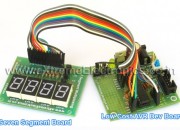Introduction to PIC Interrupts and their Handling in C
Interrupts are common features in almost all processor family, be it old 8051, AVR, PIC, ARM or the x86 used in desktops. So their in depth and clear knowledge is required for successful system software engineers. This guide will explain the interrupt system in general and their application using PIC18 architecture. We will also learn about handling of interrupts in HI-TECH C for PIC18. What are Interrupts? Interrupts, as the name suggests interrupts the normal execution and Requests and urgent attention of CPU. Interrupts are situations that the CPU can’t predict when they will happen, they can happen any time, so the CPU does not wait for them. So the CPU keeps on doing its normal job unless and interrupt occurs. For example when the USART (Serial Communication Hardware) will receive data is unknown, it can receive data any time. So the CPU keeps on doing its normal job, which may be for example read temperature using LM35 sensor and display on LCD. The CPU keeps on doing the "normal" job, but as soon as the USART receive data it informs the CPU using an interrupt. The CPU save its current state (so that it can resume), and jumps to the ISR (interrupt service routine) immediately. Where we can process the command or put it in a FIFO queue (to […]

